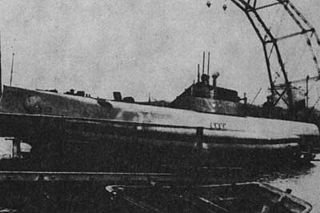Several ships and one submarine of the Royal Navy have borne the name HMS Dreadnought in the expectation that they would "dread nought", i.e. "fear nothing". The 1906 ship was one of the Royal Navy's most famous vessels; battleships built after her were referred to as 'dreadnoughts', and earlier battleships became known as pre-dreadnoughts.

A submarine is a watercraft capable of independent operation underwater. It differs from a submersible, which has more limited underwater capability. It is also sometimes used historically or colloquially to refer to remotely operated vehicles and robots, as well as medium-sized or smaller vessels, such as the midget submarine and the wet sub. Submarines are referred to as "boats" rather than "ships" irrespective of their size.

The Russian Navy is the naval arm of the Russian Armed Forces. It has existed in various forms since 1696, the present iteration of which was formed in January 1992 when it succeeded the Navy of the Commonwealth of Independent States.

Minelaying is the act of deploying explosive mines. Historically this has been carried out by ships, submarines and aircraft. Additionally, since World War I the term minelayer refers specifically to a naval ship used for deploying naval mines. "Mine planting" was the term for installing controlled mines at predetermined positions in connection with coastal fortifications or harbor approaches that would be detonated by shore control when a ship was fixed as being within the mine's effective range.
Krab or KRAB may refer to:

AS-28 is a Priz-class deep-submergence rescue vehicle of the Russian Navy, which entered service in 1986. It was designed for submarine rescue operations by the Lazurit Design Bureau in Nizhny Novgorod. It is 13.5 m (44 ft) long, 5.7 m (19 ft) high, and can operate up to a depth of 1,000 m (3,300 ft).
The name HMS Churchill has been borne by two ships of the Royal Navy; a destroyer and a submarine. The submarine is named for Winston Churchill, Prime Minister of the United Kingdom during World War II; the destroyer for towns of that name common to the United States and Britain.

The Project 58 missile cruisers, known to NATO as the Kynda class and sometimes referred to as the Grozny class, from the name of the first ship of the series to be constructed, were the first generation of Soviet missile cruisers and represented a considerable advance for the Soviet Navy. Their main role was anti-surface warfare using the SS-N-3b 'Shaddock' missile. The design proved to be top-heavy and was soon succeeded by the larger Kresta I class, but the Kyndas stayed in service until the fall of the Soviet Union.

There was sporadic naval warfare in the Mediterranean during World War I between the Central Powers' navies of Austria-Hungary, Germany and the Ottoman Empire and the Allied navies of Italy, France, Greece, Japan, America and the British Empire.

The Sierra class, Soviet designations Project 945 Barrakuda and Project 945A Kondor,, are series of nuclear-powered attack submarines intended for the Soviet Navy and currently in service with the Russian Navy.

The Leninets or L class were the second class of submarines to be built for the Soviet Navy. They were minelaying submarines and were based on the British L-class submarine, HMS L55, which was sunk during the British intervention in the Russian Civil War. Some experience from the previous Dekabrist-class submarines was also utilised. The boats were of the saddle tank type and mines were carried in two stern galleries as pioneered on the pre-war Krab, the world's first minelaying submarine. These boats were considered successful by the Soviets and 25 were built in four groups between 1931 and 1941. Groups 3 and 4 had more powerful engines and a higher top speed.

Krab was a submarine built for the Imperial Russian Navy. She was designed by Mikhail Petrovich Nalyotov as the world's first submarine minelayer, although due to construction delays the German UC submarines entered service earlier. The mines were stowed in two horizontal galleries exiting through the stern. Diving depth was 45 metres. This ship was built by the Naval yard in Nikolayev by the Black Sea. She was ordered in 1908, launched in September 1912 and entered service in 1915.

Forel was a midget submarine designed by Raimondo Lorenzo D’Equevilley-Montjustin and built by Krupp in Kiel, Germany. The design was an experimental design built as a private venture by Krupp in hopes of attracting a contract from the Imperial German Navy. Although the design proved moderately successful, the submarine did not attract German naval attention. She was purchased by the Imperial Russian Navy (IRN) in 1904 and served with the IRN until she was lost in a diving accident in 1910. She had the distinction of being the first submarine to have been built in Germany, preceding SM U-1. Forel was succeeded in service by the Krab class.
SM U-8 (Austria-Hungary) may refer to one of the following World War I German U-boats:
SM U-9 (Austria-Hungary) may refer to one of the following World War I German U-boats:
Type L submarine may refer to one of the following classes of submarines based on the British L-class submarine:
Russian submarine Kazan may refer to one of the following submarines of the Russian Navy:
Three ships of the Imperial German Navy have been named SMS Prinz Adalbert:
Four ships of the Hellenic Navy have borne the name Katsonis (Κατσώνης), after the 18th-century naval commander Lambros Katsonis:
This page is based on this
Wikipedia article Text is available under the
CC BY-SA 4.0 license; additional terms may apply.
Images, videos and audio are available under their respective licenses.









